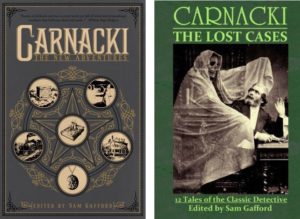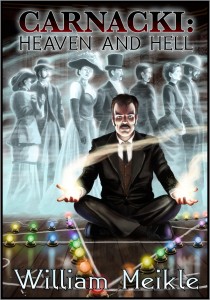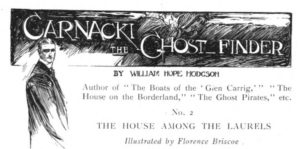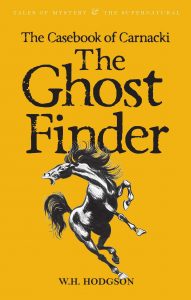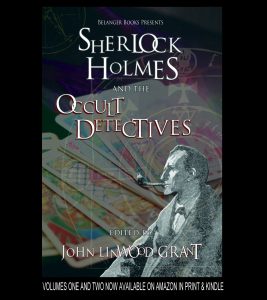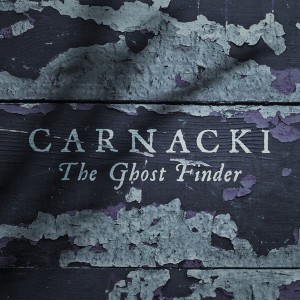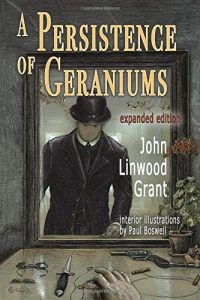Behind The Book of Carnacki: For many years my late friend Sam Gafford and I delved, quite unbeknownst to each other, into the life and works of writer William Hope Hodgson, one of the ‘uncles’ of 20th century weird fiction. Sam was in fact a leading scholar/expert on Hope Hodgson and his writings; I was a mere enthusiast. And as chance would have it, at around the same time as Sam began his studies, I had conceived of a cycle of strange stories which centred around the Edwardian era, with references – direct or in passing – to the world of Hope Hodgson’s occult detective, Carnacki the Ghost Finder. Not pastiches, but a development of period themes.
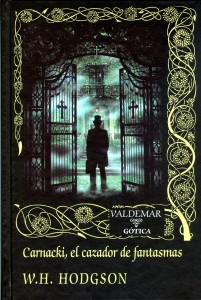
When Sam and I met on-line at last, we found that both of us had great affection for this character. Sam edited two anthologies of further Carnacki adventures (amongst other Hodgsonian publications) via his own Ulthar Press; I finally launched the series of loosely inter-connected stories called ‘Tales of the Last Edwardian’ (though I rarely write anything which features Carnacki directly). Our shared enjoyment of the character was also instrumental in us founding Occult Detective Magazine.
Sadly, Sam passed away too early, in 2019, but I was delighted last year when Belanger Books suggested following up the success of their Sherlock Holmes and the Occult Detectives anthologies with one devoted entirely to Carnacki. So, everything you need to know is laid out below.
THE SHORT VERSION
THE BOOK OF CARNACKI
A Belanger Books Project, edited by John Linwood Grant
Core concept: 5,000–10,000 word stories featuring William Hope Hodgson’s character Carnacki the Ghost Finder in a major role. Carnacki’s general behaviour and mannerisms should be canonical, much as in the original tales, though inventive and reasonable extrapolations from those are welcome. We may take a handful of stories with non-supernatural resolutions.
Also: For this particular book, we are interested in 3000–5000 word non-fiction articles relating to Carnacki and his world (see LONG VERSION below).
Your pitch must be accepted for your completed story or article to be read. See PITCH section below.
Pitch Deadline: 16 April, 2021.
Final Submission Deadline: 30 September, 2021.
Payment: Authors shall receive a payment of $100 or $50 plus 1% of the Kickstarter net profits, whichever amount is GREATER, and a paperback copy of the anthology. The Kickstarter will run March 2022, and publication of book is expected early Spring 2022.
PITCHES AND QUERIES ONLY TO occultholmes@virginmedia.com BY 16th APRIL 2021, PLEASE
You MUST put CARNACKI in the subject line of your pitch or query. Failure to do so may invalidate your submission; it may also get lost in general occult detective queries.
Reprints: We are open to the possibility of taking a small number of reprints, by negotiation. In order to receive full payment, and to increase reader interest, we would prefer that these were ‘refreshed’ or revised versions rather than straight, word-for-word reprints.
LONG VERSION
THE BOOK OF CARNACKI: THE PITCH
IF YOU DO NOT PITCH FIRST, WE WILL NOT BE ABLE TO CONSIDER YOUR STORY/ARTICLE.
Why the pitch system? Because otherwise it’s possible to end up with loads of stories which are very similar, however well written, and thus loads of rejection letters. This allows us to open to everyone, but not be swamped by works we cannot use.
For The Book of Carnacki, we require short pitches – say one hundred to three hundred words – telling us about your planned story:
- The period and general physical setting(s), e.g. London in 1905; a decaying Yorkshire farmhouse, just before WWI; a ruined castle in Scotland; Cornwall in 1899.
- The sort of supernatural threat/mystery, e.g. classic ghostly appearances; physical monstrosities on the loose; madman possessed by something; cursed item, etc. Get us intrigued.
- A hint of plot, to show you already have a story broadly in mind.
For non-fiction articles, give us an idea of your approach and focus.
If you’ve never pitched before, have a go at it, and we’ll tell you if you have something there which we think is worth pursuing. If you’ve done it before, you know the drill.
The authors of the most suitable pitches will be invited to write up a full submission for possible inclusion, so you’ll then have a further five months. No guarantees, but it means that you’re at least on the right lines; your work will get more attention and your chances will have gone up.
PITCHES AND QUERIES ONLY TO occultholmes@virginmedia.com BY 16th APRIL 2021, PLEASE
Fiction should have all the following elements:
- Thomas Carnacki as a key protagonist; a proper, authentic Hodgsonian Carnacki, in full character and with the traditional mannerisms.
- A strong APPARENT supernatural, paranormal, occult, psychic or other abnatural element which is crucial to the story. We will consider a few ‘debunking’ tales, where a mundane explanation ensues, though we won’t take many of those.
- An actual case/investigation – not Carnacki idling in his study, or buying fish for supper and thinking “I haven’t seen many ghosts lately”.
We do NOT want time-travel stories, alternate universes, alien Carnackis or steampunk. We probably don’t want Lovecraftiana, unless the latter is very clever, subtle and original, in which case we might have a glance. Draw on Hodgson’s ‘mythos’ for preference.
A FURTHER NOTE FOR WRITERS
The original six stories were published from 1910 onwards. Hope Hodgson does not mention calendar dates within the tales, so later writers have plenty of years with which to play. You can assume that Carnacki could have begun his work in the late 1880s, with a rather open end-point.
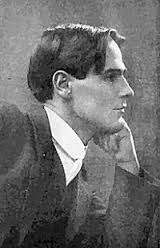
For the purposes of this anthology, and to fit with other related Belanger Books we will take the end-point to be the 1920s. So no stories set beyond 1929, please – unless you have a terrific and very imaginative take that you want to pitch. 1890 onwards, up to and including WWI and immediately after, is probably the sweet spot.
The obvious route is to pitch the outline of a Carnacki pastiche, in which the Ghost Finder investigates some strange, unlikely or horrifying event. A request for assistance by a puzzled acquaintance; a cry for help from a haunted soul, or a bizarre report in the newspapers. WE DO WANT THESE. However, the full range of possibilities includes:
- Direct and absolutely canonical pastiches, as above
- Strange tales taking Carnacki out of his usual zone – ‘weird fiction’
- Tales of his early life, and/or why he became the Ghost Finder
- Something relating specifically to his electric pentacle and scientific work (fiction or non-fiction)
- Stories or articles on his status and activities in regard to his contemporary ODs (fiction or non-fiction)
- Crossovers between Carnacki and historical figures/events
- Something relating specifically to the ‘circle’ of four men to whom all the original stories were told.
- A piece focusing on his cosmology/ theology and occultism (fiction or non-fiction)
- Even a parody, if high quality
There were nine original Carnacki stories in total. The six stories published in Hope Hodgson’s lifetime can be read or downloaded for free here:
http://www.gutenberg.org/ebooks/10832
There are affordable paperbacks of all the stories available on Amazon, though beware of cheap editions which have poor editing. A number of these are in fact exploitative editions – they call themselves ‘Annotated’ to get round Amazon’s rules, but some, for example, simply COPY word for word (without proper editing or layout) the Wikipedia entry. Disrespectful and unoriginal – please do not swell their coffers.
The Casebook of Carnacki The Ghost-Finder (Tales of Mystery & The Supernatural), from Wordsworth, edited with an introduction by David Stuart Davies, is one of the more reliable editions.
If you need a better idea of what an occult detective might be, then check the page for Occult Detective Magazine, which covers the basics and provides other links:
http://greydogtales.com/blog/occult-detective-magazine/
or pick up one of the first two volumes of Sherlock Holmes and the Occult Detectives:
A NOTE ON INCLUSIVITY AND DISCRIMINATION
It was perfectly possible in late Victorian, Edwardian and 1920s Britain to be active and respected whilst being a feminist, being Black, being LGBTQ+, or being restricted in physical ability (as just a few examples). And as far as including non-white characters, remember that between the turn of the century and 1920, there were probably 10,000 to 20,000 or more Black people living in Britain, often concentrated in areas such as London’s Canning Town. There also were many Indian and Chinese professionals, workers and students, visiting Africans, and so on. Respectful use of non-white characters is entirely appropriate (no token figures, though, please).
Whilst limited situational discrimination may occasionally be relevant in the context of the period – in order to reflect characters’ life histories or traumas – sexism, homophobia, racism etc. in general will not be accepted.
A LONGER NOTE ON THE CENTRAL CHARACTER
Why The Book of Carnacki? Many have wondered at the enduring nature of the character. The Carnacki tales were not the high point of his writing, in style or content; there had been characters who investigated strange and paranormal events before, and, to be honest, Hope Hodgson himself was never counted as part of the literary circles of the times. Yet Carnacki prospers. We have never had any doubts as to why.
Thomas Carnacki remains the first TRUE independent occult detective. Not a psychologist, mystic, doctor or intellectual; not a policeman or an arm of any agency, Lodge or ‘brotherhood’. An individual who repeatedly investigates reports of ab-natural events, and uses scientific and ordered methods in the process. One who sees each event, report or rumour as a case to which he must apply both logic and his knowledge of the ab-natural. And one who is more than willing to accept that many such events have a rational, non-supernatural explanation.
In many ways, we see him (and have even written of him) as the only occult detective of the period who might have received grudging acknowledgement from Sherlock Holmes himself – who would have been quietly satisfied with those cases where Carnacki proved that mere human perfidy was behind an apparent mystery.
And although some have questioned the sketchiness of Carnacki’s characterisation, here we have a man who admits fear, who expresses human doubts, who can laugh at his own misjudgements. Not the dry intellect or abstruse philosophies of his contemporaries, but traits of an inquisitive man trying to do his best under the circumstances.
He has no secret training from far-off monks, or natural gifts of psychic revelation; no skill at occult summonings or mastery over those beyond the Veil. He is reasonably intelligent, well-read, and willing to take risks. To augment those qualities, he has burrowed into physicists’ theories of vibrations and wavelengths; has learned the practical use of such devices as electrical apparatus and cameras, turning such use towards his occult detecting. Ellery Queen praised the character as a “ghost-breaker after Houdini’s own heart”.
We admire him for what he is, and especially for what he is not. Let Dr Silence pontificate on moral urges and spiritual alchemy; let Flaxman Low claim he knew the answer all along and then shoot everyone. Give us Thomas Carnacki, in a bit of a funk, but resolute, at our side.
For writers, the recent open call for pitches concerning the next volume of Sherlock Holmes and the Occult Detectives (Volume III) can be found here:
http://greydogtales.com/blog/sherlock-holmes-and-the-occult-detectives-iii/
“One could be forgiven for assuming Grant was a contemporary of Edwardian authors M.R. James and Arthur Conan Doyle. Each of the stories in this collection are utterly steeped in that bygone era, both in terms of setting and style.” Ginger Nuts of Horror
“Reminiscent of Saki’s stories, as a dry wit is mingled in with a singular dread. The dread is not only supernatural in nature, but also stems from the very reality that for many in the Edwardian age (and now) domesticity is a trap with teeth.” Turn to Ash
